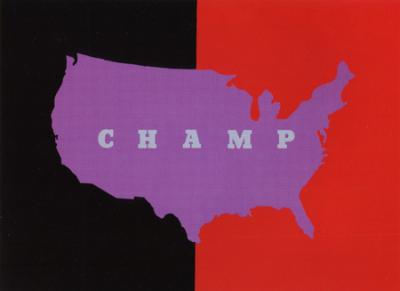Tad Savinar: review of "Nice to Meet You" at the Atlanta Contemporary Art Center

A Revealing Pairing: Nice to Meet You at the Contemporary
By Lilly Lampe
Nice to Meet You at the Atlanta Contemporary Art Center (ACAC) pairs the work of West Coast artists Tony Labat and Tad Savinar. The artists had never met prior to Artistic Director Stuart Horodner’s introduction, nor did they know of each other’s work. Nice to Meet You implies a literal introduction that brought forth a comparison and collaboration. Though Labat and Savinar have disparate practices, this exhibition creates a new context for their work that heightens the political impact of each.
It’s a successful pairing. Though they diverge in media, the tongue-in-cheek tone keeps the works in harmony. Both artists intentionally riff on art-world themes with a satirical twist. Savinar’s text-based pieces function like Jenny Holzer’s aphorisms, but display greater interest in the authoritarian way text functions on paper, applying Holzer’s fascination with stock tickers and memorials to screenprints designed to mimic them. Characteristics of a Third World Country, 2008, a series of 14 digital pigment prints lays out descriptors such as “corruptive business environment at top rungs” and “jaywalking and defiance of other simple laws.” These descriptors could easily be applied to a first-world country like America, which is the point; Savinar calls attention to the short-sightedness of a certain type of male viewpoint.
Tony Labat, on the other hand, questions the resonance of materials and images rather than text. Blanket Policy, 1989, a tent with an aluminum frame and covering made of found thrift-store paintings, questions hierarchy in the arts. These discarded, almost worthless, paintings have been stitched into a shelter. Does that use devalue them as art? Or does their use as a shelter give them new purpose? Now that they’ve been appropriated into Labat’s work, are they worth more? (Yes.)
Blanket Policy highlights valuation processes within art. Next to Savinar’s Characteristics, it takes on new meaning, recalling tent cities in Occupies across the country and the art world’s response in calling attention to marginalized groups ranging from artists to unpaid interns. As a symbol of Occupy Wall Street, is this tent a celebration of artists deemed worthless? Or an advertisement for works of this caliber? The possible meanings proliferate.
The juxtaposition between the artists also highlights the art-referential quality of Labat’s, which might otherwise be overlooked had they not worked collaboratively. Labat’s Coffee Drawing #6, 2007, a topographic target of rings in marker over coffee stains on paper, hangs next to Savinar’s Man, 2006, which lists four aspects of modern man’s ennui including “I DON’T LOVE MY WIFE” and “I’M SMARTER THAN MY BOSS.” Savinar’s statements resemble John Baldessari’s self-effacing mantra I Will Not Make Any More Boring Art (1971); this connection activates the Art Brut-ish use of coffee in Labat’s drawings and the concentric circles’ resemblance to the land art of Richard Long.
The art-world references ricochet like synaptic responses against the piercing political satire. Another pairing with a particularly razor-sharp wit is Savinar’s Champ, 1983, and Labat’s Fidel and I (Proximity), 2000. Champ, a screenprint, features the shape of the United States executed in purple atop a split black and red background. “CHAMP” is written within the country in a dull teal. The palette and medium are a hallmark of Andy Warhol’s but the proportions and cynicism are all Savinar. Communist red and anarchist black dominate the United States while “CHAMP” as a moniker is sarcastic and dated.
Labat’s Fidel and I depicts the artist with the communist Cuban dictator – or rather, Madame Tussaud’s wax version. The breakdown between art and reality in this photograph follows Arthur C. Danto’s reading of Warhol’s Brillo boxes. The wax figure is a facsimile of the real Castro, as Warhol’s Brillo boxes were a facsimile of the Brillo company’s product. In Labat’s photograph, wax Castro becomes art; the dictator’s image is just another medium in the artist’s hands.
It’s easy to imagine a younger Labat and Savinar as the authors of the oft-memed phrase “First world problems” or discussing Holzer’s early works as they were being created, until we remember they’re newly acquainted. Nice to Meet You not only succeeds in showcasing the compatibility of these West-coast conceptualists but goes further. An exhibition of these artists together reveals their many layers of reference, heightening each without overemphasizing one, and thus expands the viewer’s experience of their work.
Full article here: http://www.burnaway.org/2013/02/a-revealing-pairing-nice-to-meet-you-at-...